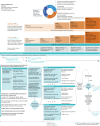Type 2 inflammation in asthma and other airway diseases
- PMID: 35923421
- PMCID: PMC9339769
- DOI: 10.1183/23120541.00576-2021
Type 2 inflammation in asthma and other airway diseases
Abstract
Chronic inflammatory airway diseases, including asthma, chronic rhinosinusitis, eosinophilic COPD and allergic rhinitis are a global health concern. Despite the coexistence of these diseases and their common pathophysiology, they are often managed independently, resulting in poor asthma control, continued symptoms and poor quality of life. Understanding disease pathophysiology is important for best treatment practice, reduced disease burden and improved patient outcomes. The pathophysiology of type 2 inflammation is driven by both the innate immune system triggered by pollutants, viral or fungal infections involving type 2 innate lymphoid cells (ILC2) and the adaptive immune system, triggered by contact with an allergen involving type 2 T-helper (Th2) cells. Both ILC2 and Th2 cells produce the type-2 cytokines (interleukin (IL)-4, IL-5 and IL-13), each with several roles in the inflammation cascade. IL-4 and IL-13 cause B-cell class switching and IgE production, release of pro-inflammatory mediators, barrier disruption and tissue remodelling. In addition, IL-13 causes goblet-cell hyperplasia and mucus production. All three interleukins are involved in trafficking eosinophils to tissues, producing clinical symptoms characteristic of chronic inflammatory airway diseases. Asthma is a heterogenous disease; therefore, identification of biomarkers and early targeted treatment is critical for patients inadequately managed by inhaled corticosteroids and long-acting β-agonists alone. The Global Initiative for Asthma guidelines recommend add-on biological (anti IgE, IL-5/5R, IL-4R) treatments for those not responding to standard of care. Targeted therapies, including omalizumab, mepolizumab, reslizumab, benralizumab, dupilumab and tezepelumab, were developed on current understanding of the pathophysiology of type 2 inflammation. These therapies offer hope for improved management of type 2 inflammatory airway diseases.
Copyright ©The authors 2022.
Conflict of interest statement
Conflict of interest: J. Maspero reports grants and personal fees from AstraZeneca, MSD, Novartis, and Sanofi, personal fees from Uriach and Inmunotek, and grants and nonfinancial support from GSK. Conflict of interest: Y. Adir reports personal fees from Teva and Sanofi, and grants and personal fees from GSK and AstraZeneca. Conflict of interest: M. Al-Ahmad has nothing to disclose. Conflict of interest: C. Celis-Preciado reports grants and personal fees from AstraZeneca and GSK, grants from Boehringer, and personal fees from Novartis and Sanofi. Conflict of interest: F.D. Colodenco has nothing to disclose. Conflict of interest: P. Giavina-Bianchi has nothing to disclose. Conflict of interest: H. Lababidi has nothing to disclose. Conflict of interest: O. Ledanois is an employee of Sanofi. Conflict of interest: B. Mahoub has nothing to disclose. Conflict of interest: D-W. Perng has nothing to disclose. Conflict of interest: J.C. Vazquez reports personal fees from AstraZeneca, Boehringer Ingelheim and Sanofi. Conflict of interest: A. Yorgancioglu reports grants/research support from AstraZeneca, MSD, and Sanofi; honoraria/consultation fees from Abdi İbrahim, AstraZeneca, Chiesi, DEVA, GSK, Novartis Sandoz and Sanofi; and other support from ERS, GARD, GINA, Turkish MoH and WHO.
Figures


References
-
- Global Initiative for Asthma. Global Strategy for Asthma Management and Prevention. 2019. https://ginasthma.org/wp-content/uploads/2019/06/GINA-2019-main-report-J.... Date last accessed: January 2021.
Publication types
LinkOut - more resources
Full Text Sources
Other Literature Sources
